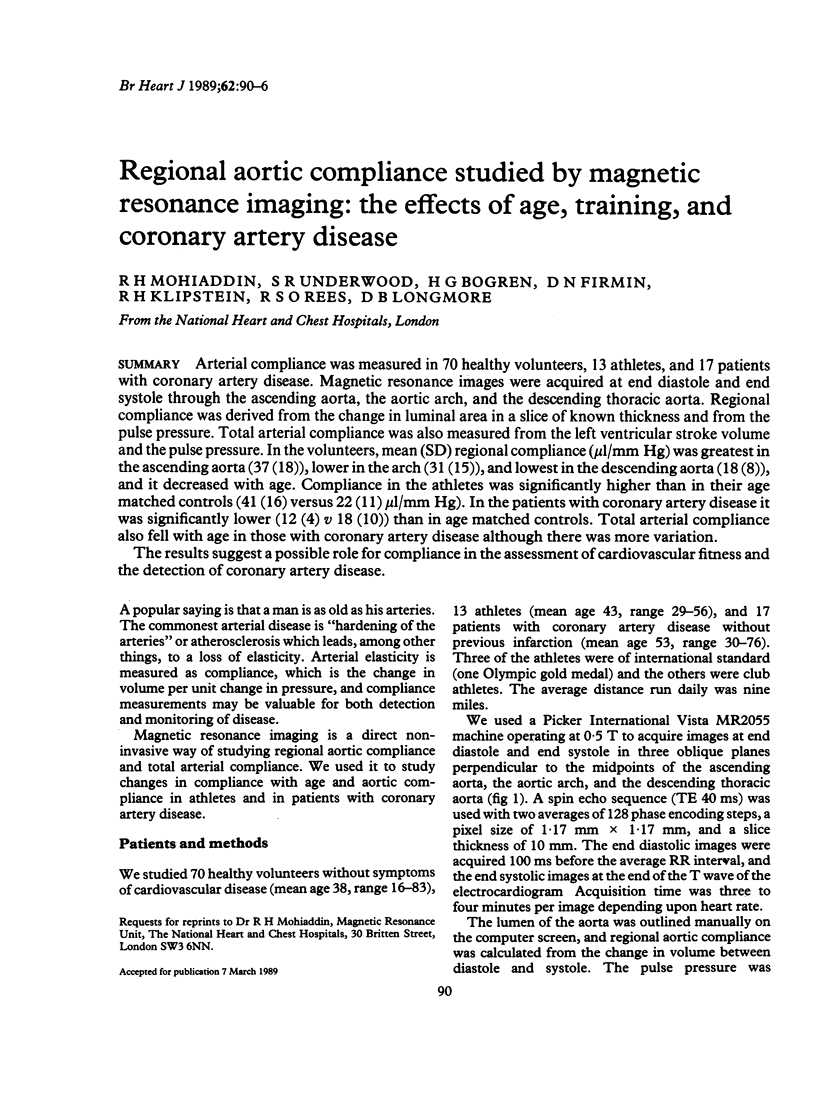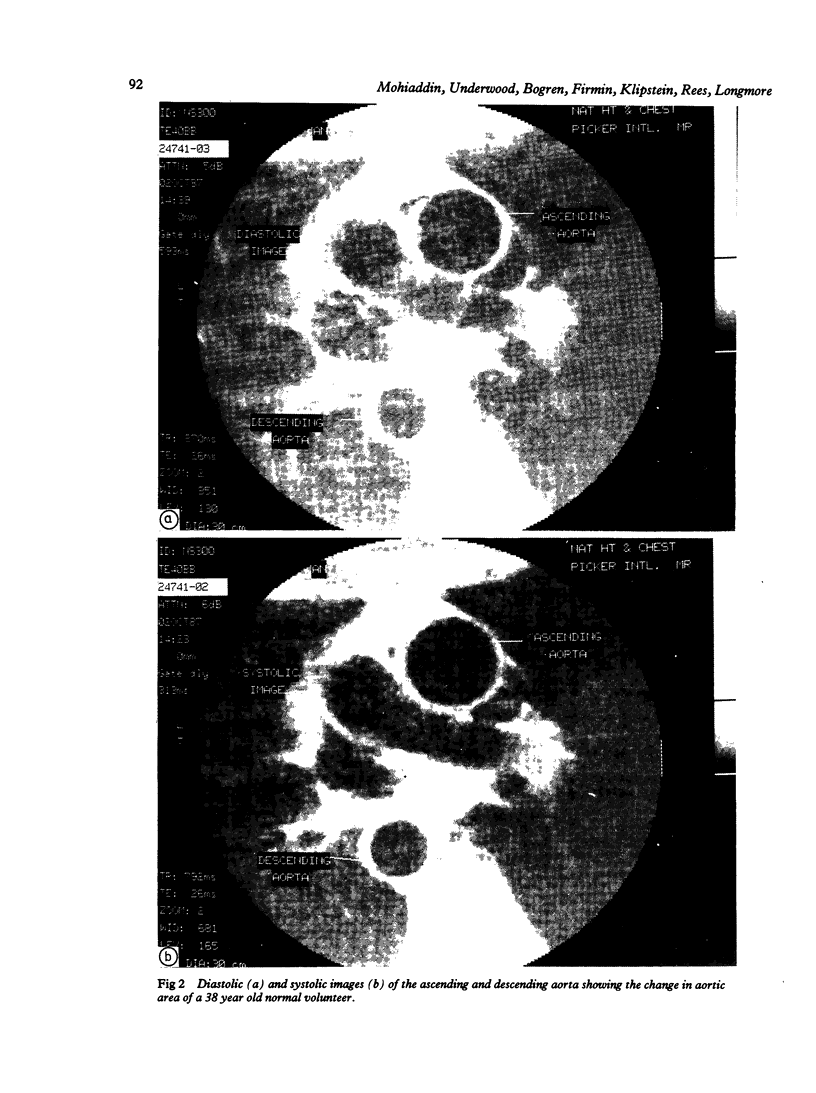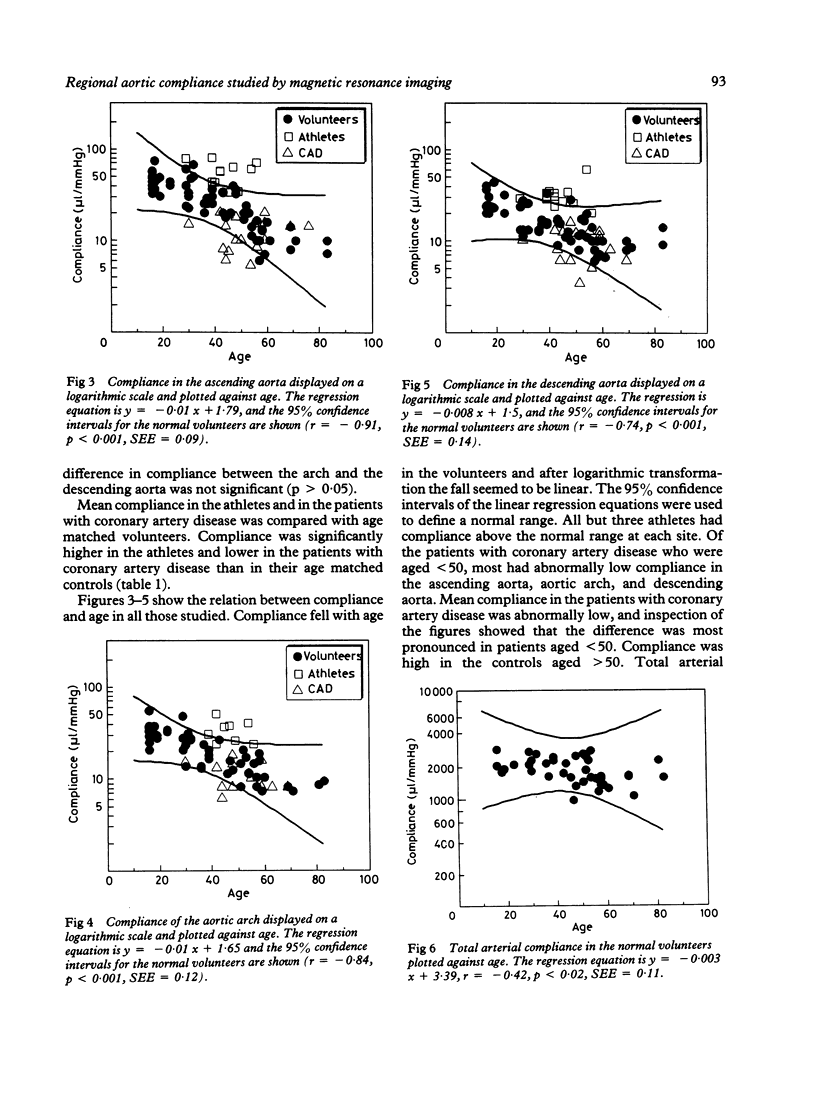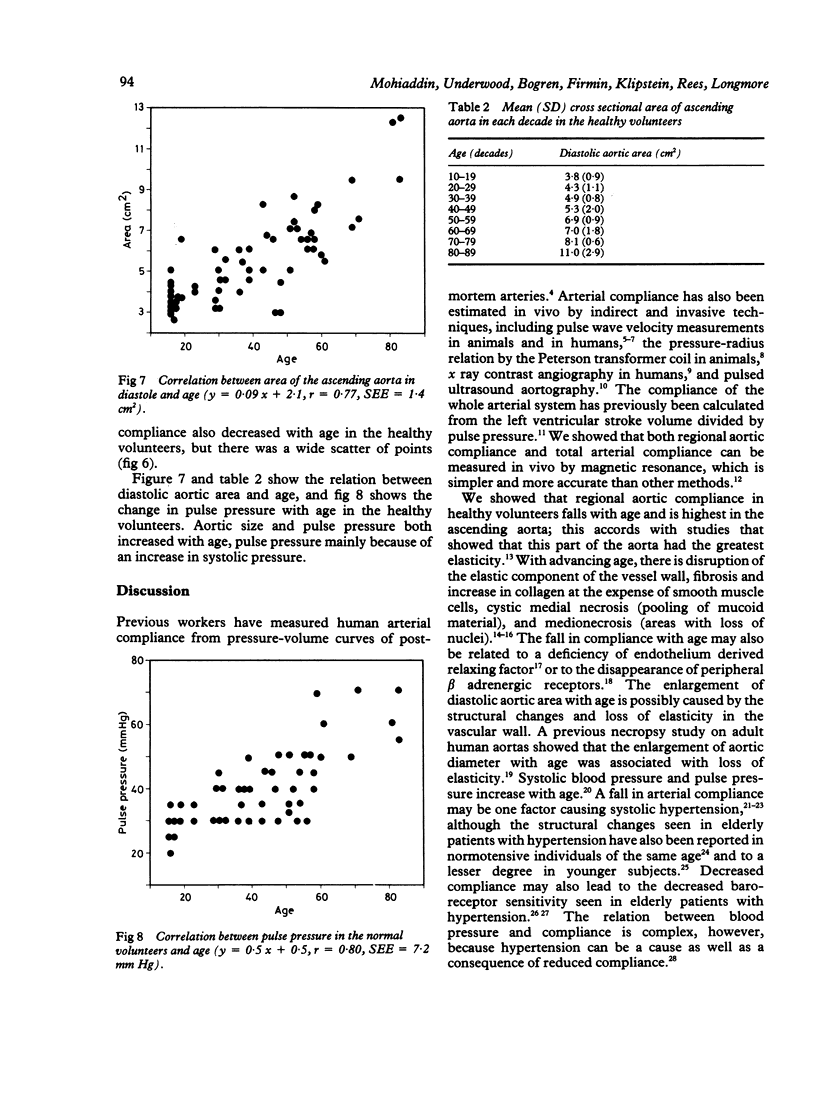Abstract
Arterial compliance was measured in 70 healthy volunteers, 13 athletes, and 17 patients with coronary artery disease. Magnetic resonance images were acquired at end diastole and end systole through the ascending aorta, the aortic arch, and the descending thoracic aorta. Regional compliance was derived from the change in luminal area in a slice of known thickness and from the pulse pressure. Total arterial compliance was also measured from the left ventricular stroke volume and the pulse pressure. In the volunteers, mean (SD) regional compliance (microliters/mm Hg) was greatest in the ascending aorta (37 (18], lower in the arch (31 (15], and lowest in the descending aorta (18 (8], and it decreased with age. Compliance in the athletes was significantly higher than in their age matched controls (41 (16) versus 22 (11) microliters/mm Hg). In the patients with coronary artery disease it was significantly lower (12 (4) v 18 (10] than in age matched controls. Total arterial compliance also fell with age in those with coronary artery disease although there was more variation. The results suggest a possible role for compliance in the assessment of cardiovascular fitness and the detection of coronary artery disease.
Full text
PDF






Images in this article
Selected References
These references are in PubMed. This may not be the complete list of references from this article.
- Azuma T., Hasegawa M. A rheological approach to the architecture of arterial walls. Jpn J Physiol. 1971 Feb;21(1):27–47. doi: 10.2170/jjphysiol.21.27. [DOI] [PubMed] [Google Scholar]
- BANGA I., BALO J. Elasticity of the vascular wall. I. The elastic tensibility of the human carotid as a function of age and arteriosclerosis. Acta Physiol Acad Sci Hung. 1961;20:237–247. [PubMed] [Google Scholar]
- Blomqvist C. G., Saltin B. Cardiovascular adaptations to physical training. Annu Rev Physiol. 1983;45:169–189. doi: 10.1146/annurev.ph.45.030183.001125. [DOI] [PubMed] [Google Scholar]
- Clausen J. P. Circulatory adjustments to dynamic exercise and effect of physical training in normal subjects and in patients with coronary artery disease. Prog Cardiovasc Dis. 1976 May-Jun;18(6):459–495. doi: 10.1016/0033-0620(76)90012-8. [DOI] [PubMed] [Google Scholar]
- Clausen J. P. Effect of physical training on cardiovascular adjustments to exercise in man. Physiol Rev. 1977 Oct;57(4):779–815. doi: 10.1152/physrev.1977.57.4.779. [DOI] [PubMed] [Google Scholar]
- Eggen D. A., Solberg L. A. Variation of atherosclerosis with age. Lab Invest. 1968 May;18(5):571–579. [PubMed] [Google Scholar]
- Farrar D. J., Green H. D., Wagner W. D., Bond M. G. Reduction in pulse wave velocity and improvement of aortic distensibility accompanying regression of atherosclerosis in the rhesus monkey. Circ Res. 1980 Sep;47(3):425–432. doi: 10.1161/01.res.47.3.425. [DOI] [PubMed] [Google Scholar]
- Ferguson J. J., 3rd, Randall O. S. Hemodynamic correlates of arterial compliance. Cathet Cardiovasc Diagn. 1986;12(6):376–380. doi: 10.1002/ccd.1810120604. [DOI] [PubMed] [Google Scholar]
- Griffith T. M., Lewis M. J., Newby A. C., Henderson A. H. Endothelium-derived relaxing factor. J Am Coll Cardiol. 1988 Sep;12(3):797–806. doi: 10.1016/0735-1097(88)90324-5. [DOI] [PubMed] [Google Scholar]
- HAMILTON M., PICKERING G. W., ROBERTS J. A. F., SOWRY G. S. The aetiology of essential hypertension. I. The arterial pressure in the general population. Clin Sci. 1954 Feb;13(1):11–35. [PubMed] [Google Scholar]
- Hallock P., Benson I. C. STUDIES ON THE ELASTIC PROPERTIES OF HUMAN ISOLATED AORTA. J Clin Invest. 1937 Jul;16(4):595–602. doi: 10.1172/JCI100886. [DOI] [PMC free article] [PubMed] [Google Scholar]
- Kuylenstierna J., Karlberg B. E., Morales O. Prostaglandin E2, renin and angiotensin II in renovascular hypertension. J Hypertens. 1984 Aug;2(4):397–403. [PubMed] [Google Scholar]
- LUCHSINGER P. C., SACHS M., PATEL D. J. Pressure-radius relationship in large blood vessels of man. Circ Res. 1962 Nov;11:885–888. doi: 10.1161/01.res.11.5.885. [DOI] [PubMed] [Google Scholar]
- Longmore D. B., Klipstein R. H., Underwood S. R., Firmin D. N., Hounsfield G. N., Watanabe M., Bland C., Fox K., Poole-Wilson P. A., Rees R. S. Dimensional accuracy of magnetic resonance in studies of the heart. Lancet. 1985 Jun 15;1(8442):1360–1362. doi: 10.1016/s0140-6736(85)91786-6. [DOI] [PubMed] [Google Scholar]
- Messerli F. H., Ventura H., Aristimuno G. G., Suarez D. H., Dreslinski G. R., Frohlich E. D. Arterial compliance in systolic hypertension. Clin Exp Hypertens A. 1982;4(7):1037–1044. doi: 10.3109/10641968209060772. [DOI] [PubMed] [Google Scholar]
- REMINGTON J. W. Pressure-diameter relations of the in vivo aorta. Am J Physiol. 1962 Sep;203:440–448. doi: 10.1152/ajplegacy.1962.203.3.440. [DOI] [PubMed] [Google Scholar]
- Randall O. S., Esler M. D., Calfee R. V., Bulloch G. F., Maisel A. S., Culp B. Arterial compliance in hypertension. Aust N Z J Med. 1976;6 Suppl 2:49–59. doi: 10.1111/j.1445-5994.1976.tb03323.x. [DOI] [PubMed] [Google Scholar]
- Randall O. S., van den Bos G. C., Westerhof N. Systemic compliance: does it play a role in the genesis of essential hypertension? Cardiovasc Res. 1984 Aug;18(8):455–462. doi: 10.1093/cvr/18.8.455. [DOI] [PubMed] [Google Scholar]
- Randall O., Esler M., Culp B., Julius S., Zweifler A. Determinants of baroreflex sensitivity in man. J Lab Clin Med. 1978 Mar;91(3):514–519. [PubMed] [Google Scholar]
- Schlatmann T. J., Becker A. E. Histologic changes in the normal aging aorta: implications for dissecting aortic aneurysm. Am J Cardiol. 1977 Jan;39(1):13–20. doi: 10.1016/s0002-9149(77)80004-0. [DOI] [PubMed] [Google Scholar]
- Schocken D. D., Roth G. S. Reduced beta-adrenergic receptor concentrations in ageing man. Nature. 1977 Jun 30;267(5614):856–858. doi: 10.1038/267856a0. [DOI] [PubMed] [Google Scholar]
- Simon A. C., Safar M. A., Levenson J. A., Kheder A. M., Levy B. I. Systolic hypertension: hemodynamic mechanism and choice of antihypertensive treatment. Am J Cardiol. 1979 Sep;44(3):505–511. doi: 10.1016/0002-9149(79)90404-1. [DOI] [PubMed] [Google Scholar]
- Simon A. C., Safar M. E., Weiss Y. A., London G. M., Milliez P. L. Baroreflex sensitivity and cardiopulmonary blood volume in normotensive and hypertensive patients. Br Heart J. 1977 Jul;39(7):799–805. doi: 10.1136/hrt.39.7.799. [DOI] [PMC free article] [PubMed] [Google Scholar]
- Simon A., Levenson J. Overview on atherosclerotic systolic hypertension. Int J Cardiol. 1987 Jul;16(1):1–18. doi: 10.1016/0167-5273(87)90265-8. [DOI] [PubMed] [Google Scholar]
- Spina M., Garbin G. Age-related chemical changes in human elastins from non-atherosclerotic areas of thoracic aorta. Atherosclerosis. 1976 Jul-Aug;24(1-2):267–279. doi: 10.1016/0021-9150(76)90082-4. [DOI] [PubMed] [Google Scholar]
- Stefanadis C., Wooley C. F., Bush C. A., Kolibash A. J., Boudoulas H. Aortic distensibility abnormalities in coronary artery disease. Am J Cardiol. 1987 Jun 1;59(15):1300–1304. doi: 10.1016/0002-9149(87)90908-8. [DOI] [PubMed] [Google Scholar]
- Underwood S. R., Gill C. R., Firmin D. N., Klipstein R. H., Mohiaddin R. H., Rees R. S., Longmore D. B. Left ventricular volume measured rapidly by oblique magnetic resonance imaging. Br Heart J. 1988 Sep;60(3):188–195. doi: 10.1136/hrt.60.3.188. [DOI] [PMC free article] [PubMed] [Google Scholar]
- Urschel C. W., Covell J. W., Sonnenblick E. H., Ross J., Jr, Braunwald E. Effects of decreased aortic compliance on performance of the left ventricle. Am J Physiol. 1968 Feb;214(2):298–304. doi: 10.1152/ajplegacy.1968.214.2.298. [DOI] [PubMed] [Google Scholar]
- WILCKEN D. E., CHARLIER A. A., HOFFMAN J. I., GUZ A. EFFECTS OF ALTERATIONS IN AORTIC IMPEDANCE ON THE PERFORMANCE OF THE VENTRICLES. Circ Res. 1964 Apr;14:283–293. doi: 10.1161/01.res.14.4.283. [DOI] [PubMed] [Google Scholar]
- Wilens S. L. The Postmortem Elasticity of the Adult Human Aorta. Its Relation to Age and to the Distribution of Intimal Atheromas. Am J Pathol. 1937 Sep;13(5):811–834.3. [PMC free article] [PubMed] [Google Scholar]




